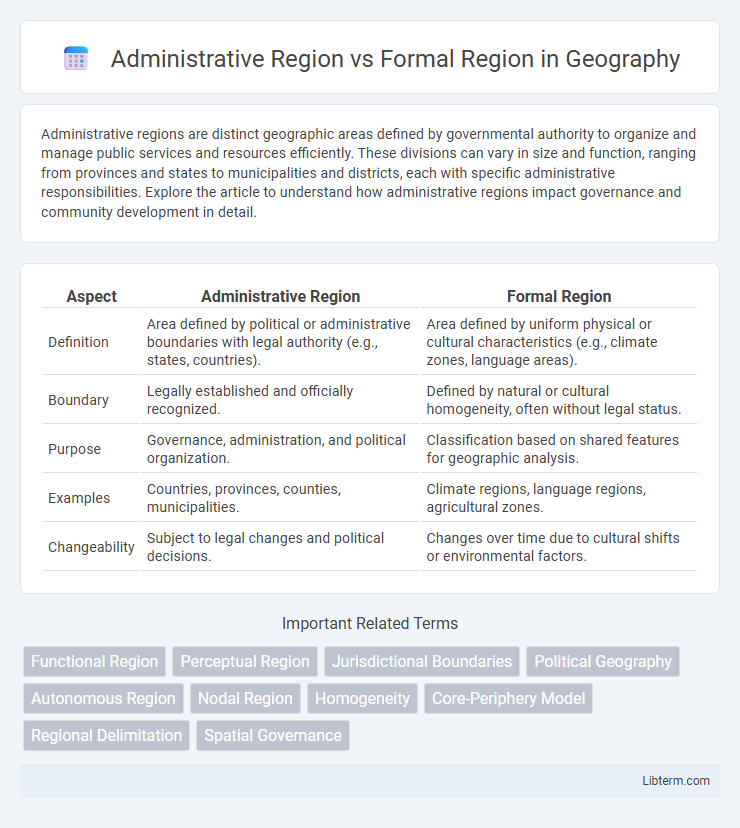Administrative regions are distinct geographic areas defined by governmental authority to organize and manage public services and resources efficiently. These divisions can vary in size and function, ranging from provinces and states to municipalities and districts, each with specific administrative responsibilities. Explore the article to understand how administrative regions impact governance and community development in detail.
Table of Comparison
| Aspect | Administrative Region | Formal Region |
|---|---|---|
| Definition | Area defined by political or administrative boundaries with legal authority (e.g., states, countries). | Area defined by uniform physical or cultural characteristics (e.g., climate zones, language areas). |
| Boundary | Legally established and officially recognized. | Defined by natural or cultural homogeneity, often without legal status. |
| Purpose | Governance, administration, and political organization. | Classification based on shared features for geographic analysis. |
| Examples | Countries, provinces, counties, municipalities. | Climate regions, language regions, agricultural zones. |
| Changeability | Subject to legal changes and political decisions. | Changes over time due to cultural shifts or environmental factors. |
Definition of Administrative Region
An administrative region is a designated area governed by a structured political or governmental authority, typically with defined boundaries established for administrative purposes such as law enforcement, public services, and governance. This type of region is formally recognized by official legislation or government entities, differentiating it from informal or cultural classifications. In contrast, a formal region is characterized by uniformity in a specific attribute, such as language, climate, or economic activity, without necessarily having official administrative boundaries.
Definition of Formal Region
A formal region is defined by uniform characteristics such as language, climate, or political boundaries that create a cohesive and measurable area. Administrative regions are specifically designated areas governed by official institutions and legal frameworks, such as states, counties, or municipalities. The distinction lies in formal regions being defined by shared traits, while administrative regions are outlined by governance and administrative control.
Key Characteristics of Administrative Regions
Administrative regions are defined by legally recognized boundaries established by government authorities to facilitate governance, resource management, and public administration. These regions often include countries, states, provinces, or municipalities, characterized by officially designated borders, political leadership, and jurisdictional authority. Unlike formal regions that are identified based on shared physical or cultural traits, administrative regions prioritize governance, law enforcement, and administrative functions.
Key Characteristics of Formal Regions
Formal regions are defined by uniformity in specific characteristics, such as language, climate, or economic activity, that are consistent throughout the area. These regions have clearly delineated boundaries based on measurable criteria, often established through statistical data or geographic features. Unlike administrative regions governed by political or legal authority, formal regions emphasize homogeneous traits that unify the territory.
Examples of Administrative Regions
Administrative regions include legally defined government boundaries such as states, provinces, counties, and municipalities, exemplified by California in the United States, Bavaria in Germany, and Ontario in Canada. These regions serve specific political or administrative purposes, with official governance structures and jurisdictional authority. In contrast, formal regions are defined by uniform characteristics like climate or language, such as the Sahara Desert or Latin America, without formal political boundaries.
Examples of Formal Regions
Formal regions are areas defined by uniform characteristics such as language, climate, or economic activity; examples include the Sahara Desert, characterized by its arid climate, or the Rust Belt in the United States, known for its industrial history. These regions have clearly defined boundaries based on quantifiable traits, unlike administrative regions established by political or legal criteria. Understanding formal regions helps in geographic analysis by highlighting natural or cultural uniformity across specific locations.
Purpose and Functions of Administrative Regions
Administrative regions serve as legally defined territorial units established by governments to facilitate governance, resource management, and public administration, ensuring efficient implementation of laws and policies. Their primary function includes organizing political authority, coordinating public services, and managing socio-economic development within their boundaries. In contrast, formal regions are defined by uniform characteristics, such as language or climate, without administrative authority, focusing more on spatial analysis than practical governance.
Purpose and Functions of Formal Regions
Formal regions are defined by uniform characteristics such as language, climate, or political boundaries, serving the purpose of categorizing areas for analysis and governance. Their functions include facilitating administrative control, resource management, and policy implementation within clearly established limits. In contrast, administrative regions strictly correspond to official governmental jurisdictions with legally recognized boundaries and enforcement authority.
Differences Between Administrative and Formal Regions
Administrative regions are defined by political or governmental boundaries, such as states, provinces, or municipalities, created for managing public affairs and administration. Formal regions are characterized by uniform physical, cultural, or economic traits, like language zones or climate types, and exist based on shared attributes rather than political authority. The key difference lies in administrative regions' reliance on legal jurisdiction and governance, while formal regions are identified through consistent patterns or characteristics across an area.
Importance of Understanding Regional Classifications
Understanding the distinction between Administrative Regions, defined by governmental boundaries and legal jurisdictions, and Formal Regions, characterized by uniform physical or cultural traits, is crucial for effective policy-making and resource allocation. Accurate regional classification enhances targeted infrastructure development, disaster management, and socio-economic planning by aligning strategies with the specific characteristics and governance structures of each region. This comprehension supports sustainable growth and improves the delivery of public services by recognizing the nuanced differences within spatial units.
Administrative Region Infographic

 libterm.com
libterm.com